Последние версии Windows 10 включают в себя новую функцию для геймеров. Она называется «Режим Полноэкранной Оптимизации». Если функция включена, она позволяет операционной системе оптимизировать производительность игр и приложений, когда они находятся в полноэкранном режиме. Однако некоторые пользователи заметили, что данная оптимизация может не работать должным образом и не повышает производительность приложений, как ожидалось. Если вы получаете побочные эффекты, такие как понижение производительности для отдельных игр с включенной функцией, вы можете попытаться отключить ее.
По умолчанию функция полноэкранной оптимизаций включена и доступна начиная с Windows build 17093.
Как вы уже знаете, Windows 10 имеет специальную функцию игрового режима, которая создана специально для геймеров. Функция повышает производительность и приоритет игр. Она уделяет приоритетное внимание ресурсам ЦП и графики (GPU), чтобы сделать игру более быстрой и плавной. Новая функция «Режим Полноэкранной Оптимизации» является частью оптимизации игр в Windows 10.
Если у вас есть проблемы с производительностью во время игр и функция «Режим Полноэкранной Оптимизации» включена, есть несколько способов отключить ее. Вы можете использовать «Параметры», настройку реестра, либо параметры совместимости для классических игр (не из магазина). Давайте рассмотрим подробнее эти способы.
Чтобы отключить «Режим Полноэкранной Оптимизации» в Windows 10 , выполните следующие действия.
- Откройте приложение «Параметры», нажав на значок шестеренки в меню «Пуск» или сочетание клавиш Win + I.
- Перейдите в раздел «Система» → «Дисплей».
- Прокрутите страницу в низ, найдите и нажмите ссылку — «Дополнительные графические параметры».
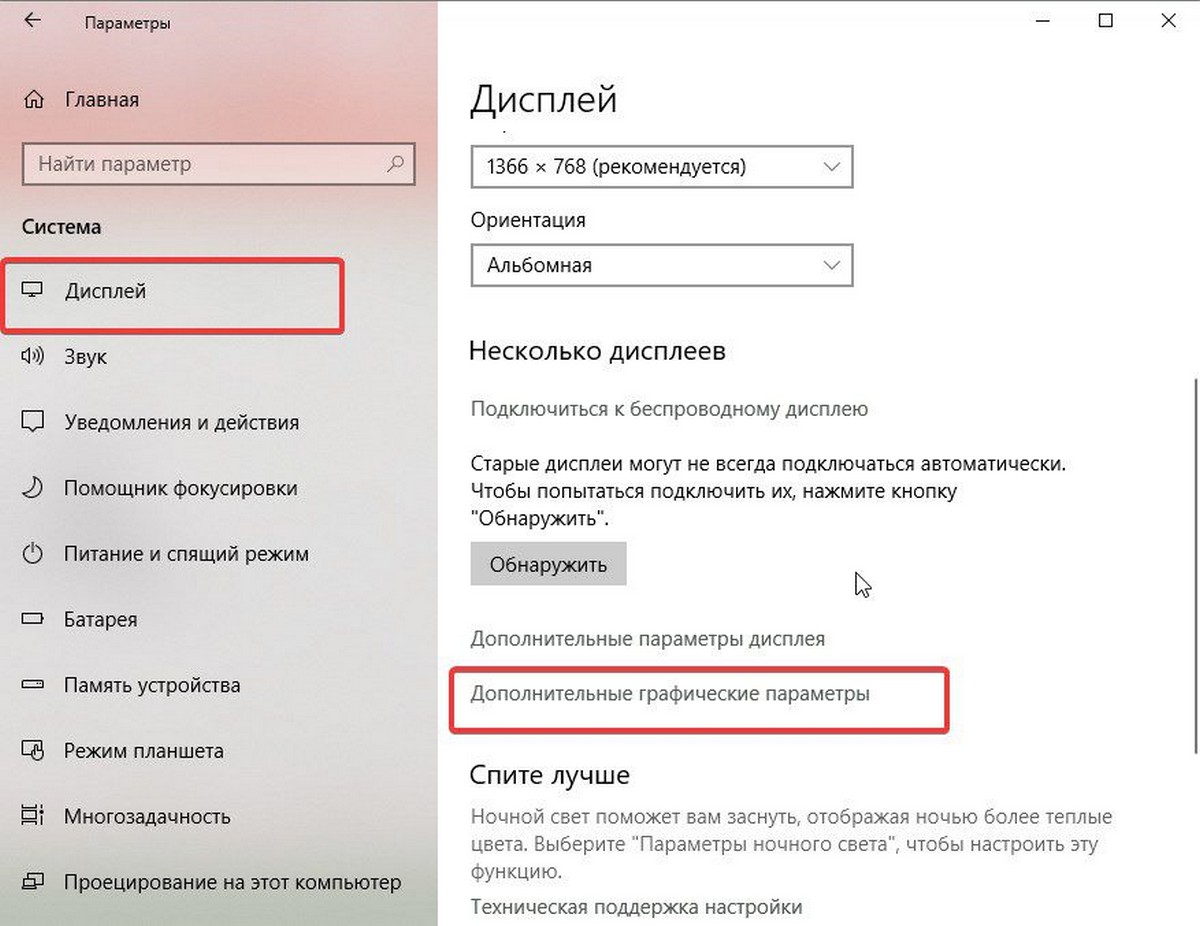
- На следующей странице отключите (снимите галочку) параметра «Включить оптимизацию в полноэкранном режиме».
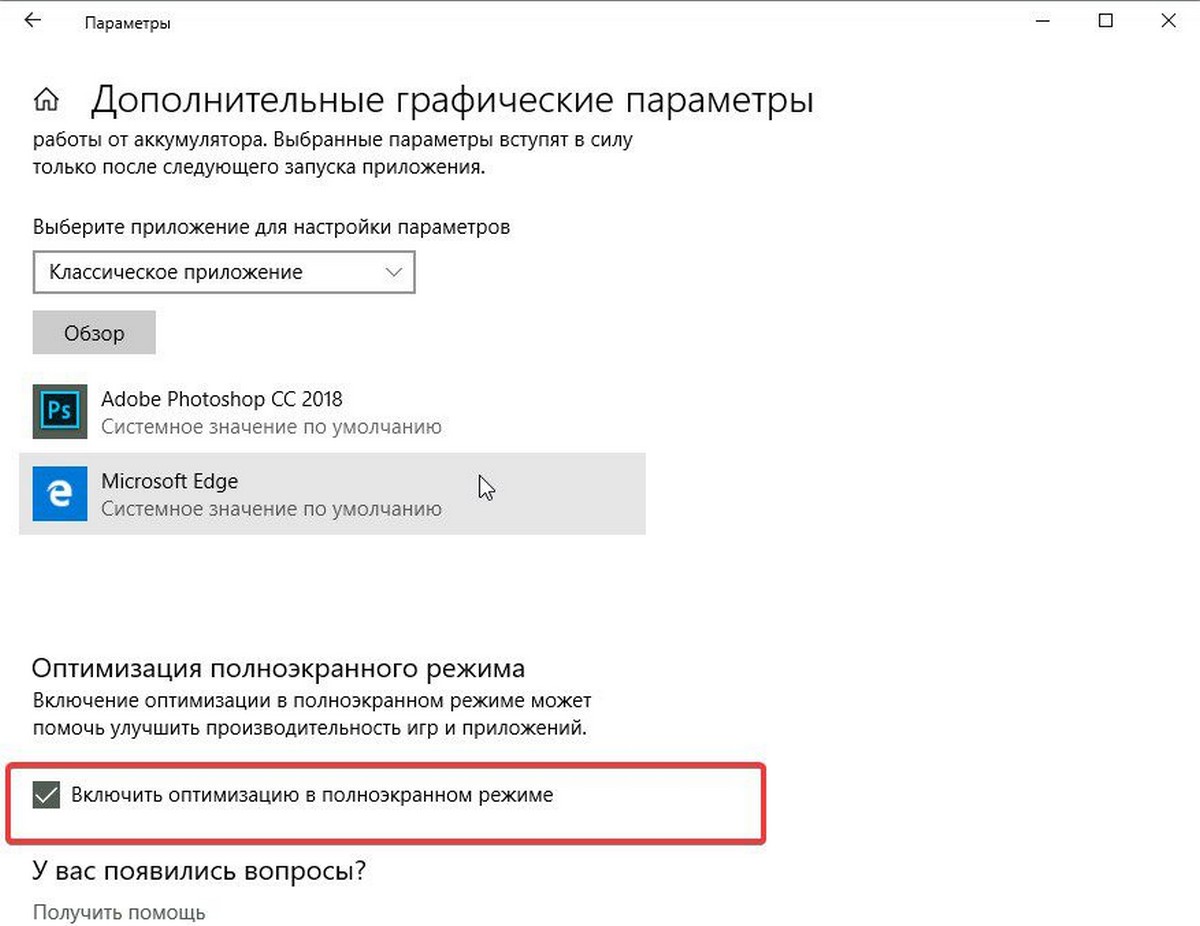
Все. Это изменение будет применяться ко всем приложениям, которые вы запускаете под учетной записью пользователя в Windows 10 на данном ПК.
Кроме того, этот параметр можно включить или отключить с помощью твика реестра.
Включить или отключить полноэкранный режим оптимизации с помощью настройки реестра.
- Откройте приложение «Редактор реестра».
- Перейдите к следующему разделу реестра.
HKEY_CURRENT_USER\System\GameConfigStore
- Справа измените или создайте новый параметр DWORD (32 бита) с именем — GameDVR_FSEBehavior.
Примечание. Даже если вы используете 64-битную Windows, вы все равно должны создать параметр DWORD (32 бита).
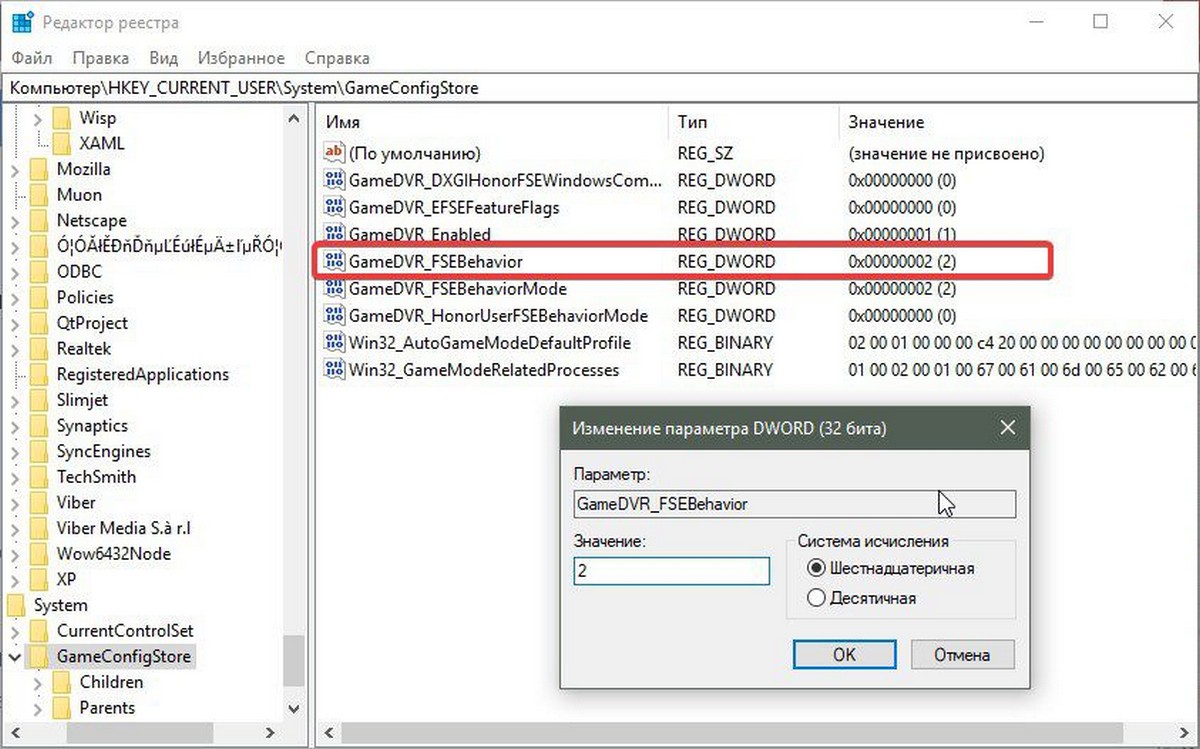
- Установите для параметра GameDVR_FSEBehavior значение равным 2, это позволит отключить его. Чтобы снова включить функцию, установите значение равным 0.
- Чтобы изменения, внесенные с помощью настройки реестра, вступили в силу, вам нужно выйти и войти в свою учетную запись пользователя.
Наконец, вы можете отключить функцию полноэкранного режима оптимизации для отдельных приложений. Это применимо к классическим играм, которые реализованы как настольные приложения.
Отключить полноэкранную оптимизацию для конкретного приложения.
- Кликните правой кнопкой мыши на исполняемый файл приложения или игры, для которой вы хотите отключить оптимизацию.
- В контекстном меню выберите «Свойства».
- Перейдите на вкладку «Совместимость».
- Включите параметр установив флажок для «Отключить оптимизацию во весь экран».

Это отключит полноэкранную оптимизацию для конкретного приложения для текущего пользователя.
Чтобы отключить оптимизацию для всех пользователей.
- Кликните правой кнопкой мыши на исполняемый файл приложения или игры, для которой вы хотите отключить оптимизацию.
- В контекстном меню выберите «Свойства».
- Перейдите на вкладку «Совместимость».
- Нажмите кнопку «Изменить параметры для всех пользователей».
…Кнопка «Изменение параметров для всех пользователей Windows 10»

- И задействуйте параметр «Отключить полноэкранный режим».
Вот и все.
You are here: Home / Windows / How To Disable Fullscreen Optimizations In Windows 11/10
This article has been updated to be relevant for Windows 11 users.
The Fullscreen optimization feature in Windows 11 and 10 was introduced to make the gaming and video playing experience better for users.
When the Fullscreen Optimization feature is enabled, your PC prioritizes the CPU and GPU resources to enhance the games and playback videos.
But, this feature was soon reported to be responsible for FPS drops and other bugs.
Here, I have shown how to disable Fullscreen Optimization in Windows 10 and 11. So, keep reading.
Earlier, it was quite easy to disable the Fullscreen Optimization on Windows, as there was a dedicated option for it.
Later, the option was removed, and now Windows 10 and 11 use the Fullscreen Optimization feature by default. There is still a registry trick to disable it for all apps, which I have shown, but it’s not foolproof.
However, Windows allows users to disable Fullscreen optimation for individual apps. Here is how you can do it!
Turn Off Fullscreen Optimization For A Single Application
The option to disable Fullscreen Optimization for all apps may have been removed on Windows 10 and 11 by conventional means, but you can still disable it for individual apps. Here is how you can do it:
- Right-click on the app or game that you want to start without Fullscreen Optimization.
- Click on the Properties option from the right-click context menu.
- Select the Compatibility option.
- In the Settings section, check the Disable fullscreen optimizations option.
- Click on Apply and OK to save the changes.
Now the application will start without using the Fullscreen Optimizations feature.
This will be the case every time you open this app in that particular user account until you uncheck the Disable fullscreen optimization box from properties.
However, this won’t be the case for all the user accounts on your PC. To disable the Fullscreen Optimization for a particular app or game in all the user accounts in your PC, follow the steps given below:
- Open the Compatibility tab in the Properties of the app or game as mentioned above.
- Click on the Change settings for all users option.
- Check the Disable fullscreen optimizations option.
- Click on Apply and OK to save the changes.
Turn Off Fullscreen Optimization From Registry
To disable it for all apps in the latest Windows 10 version and Windows 11, you must make some changes in the Registry.
Windows Registry is the place where all the Windows settings are stored. When you make a Registry change, you need to be extra careful as even a small mistake can lead to a complete system crash.
NOTE: Before following the steps given below, backup the Registry keys or create a system restore point. This will allow you to restore any mistakes you make in the Registry.
Now, to disable Fullscreen Optimization from Registry, follow the steps given below:
- Press the Windows + R keys to open the Run utility.
- Type regedit and press Enter to open the Registry Editor.
- Navigate to the following registry key:
HKEY_CURRENT_USER\System\GameConfigStore - On the right panel, right-click on the empty white area and select New >> DWORD (32-bit) Value. This will create a new DWORD.
- Name the new DWORD GameDVR_DSEBehavior and double-click on it.
- Set 2 as the value to disable Fullscreen Optimization. Click on OK to save the changes.
If you want to enable Fullscreen Optimization again, then simply change the value to 0 from 2. - Finally, close the Registry Editor and restart the computer.
After the computer starts, Fullscreen Optimization will be disabled.
Turn Off Fullscreen Optimization From Settings (For Users With Older Windows 10 Versions)
The following methods no longer work for the latest versions of Windows 10 and 11. But if you are using an older version of Windows 10, then you can still use it.
Here is how you can do it:
- Right-click on the Start menu and select the Settings option. This will open the Settings app on your screen.
- In the Settings app, click on the System option.
- Next, click on the Display option.
- Scroll down and select the Advanced Graphics settings option.
- Now, uncheck the Enable Fullscreen Optimization box in the Fullscreen Optimization section.
If this option is unavailable on your PC, then try the next two methods.
Wrapping Up
So, there you have it. Now you know how to disable Fullscreen Optimizations in Windows 10 and 11.
Remember to backup your Registry or create a system restore point before editing the Registry keys.
If you have any other questions regarding this article, ask them in the comment section below.
Download Windows Speedup Tool to fix errors and make PC run faster
Full-Screen Optimizations is a feature on Windows devices that help them function better. It is enabled by default for applications like video players and games. When this feature is enabled, the gaming or video playback experience is enhanced by prioritizing the CPU and GPU resources for that particular process. But sometimes, it results in a drop in the frame rate (FPS) when in full-screen mode. The solution to fix these frame drops would be to disable these full-screen optimizations. But unfortunately, Microsoft has removed this features for Windows 11/10 in the recent releases – but there is still a way you can get this done.
In this guide, we will cover the following ways:
- Using the Registry Editor.
- Applicable to a particular set of users.
- Applicable for all the users.
- Using Windows 10 Settings.
1] Using the Registry Editor
Hit the WINKEY + R button combination to launch the Run utility, type in regedit and hit Enter. Click on Yes for the UAC or User Account Control Prompt that you get.
Once Registry Editor opens, navigate to the following key location-
HKEY_CURRENT_USER\System\GameConfigStore
Now right click on Explorer. Select New > DWORD (32-bit) Value.
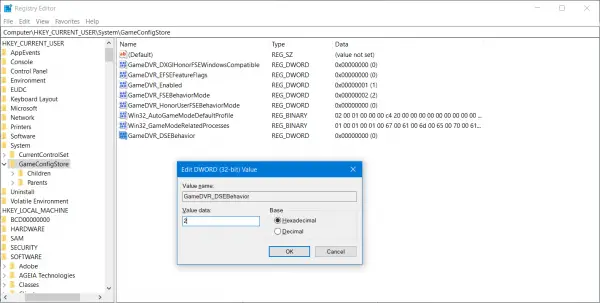
Name the newly created DWORD to GameDVR_DSEBehavior and hit Enter to save it.
Double click on the GameDVR_DSEBehavior DWORD and set its value to the following depending on your choice,
- 2: Disable Fullscreen optimizations.
- 0: Enable Fullscreen optimizations.
After you are done setting a value, close the Registry Editor and Reboot your computer for the changes to take effect.
2] Applicable to a particular set of users
Start by locating the main executable file of the application or game for which you need to enable or disable the fullscreen optimizations.
Right-click on the located executable file and click on Properties. Switch the tab labeled as Compatibility. Under the section labeled as Settings.
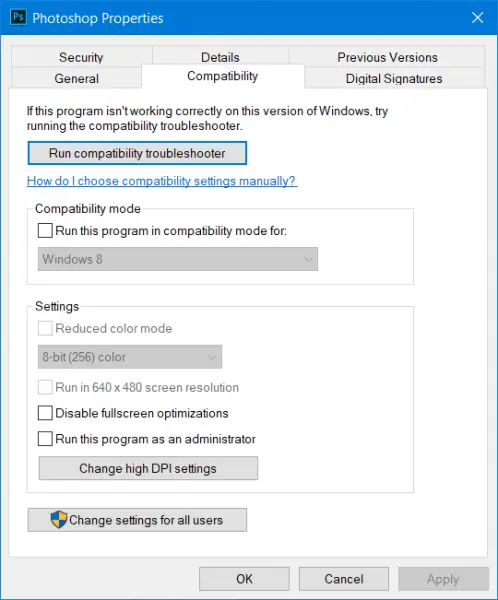
Check the option labeled as Disable fullscreen optimizations in order to disable the feature and vice versa for the opposite.
Click on Apply and then click on OK for the settings to be applied.
3] Applicable to all the users
Start by locating the main executable file of the application or game for which you need to enable or disable the fullscreen optimizations.
Right-click on the located executable file and click on Properties. Switch the tab labeled as Compatibility.
Click on the button labeled as Change settings for all users on the bottom part of the mini window.

Under the section labeled as Settings.
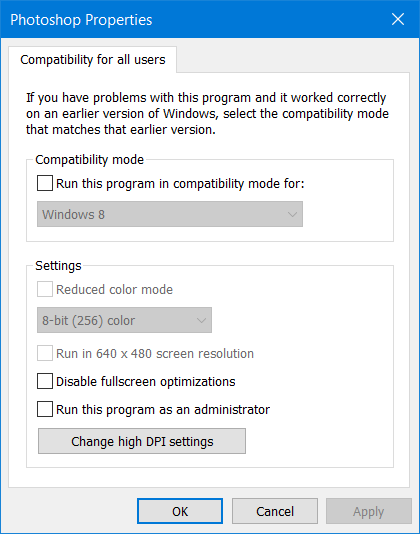
Check the option labeled as Disable fullscreen optimizations in order to disable the feature and vice versa for the opposite.
Click on Apply and then click on OK for the settings to be applied.
4] Using Windows Settings (Earlier Windows 10 releases only)
For earlier releases, you can follow this method. This method is not available for releases starting Windows 10 v1803.
Launch the Windows 10 Settings app. Now, navigate to System > Display. Scroll down a bit and click on the Graphics Settings link. This will open the Advanced Graphics settings page.
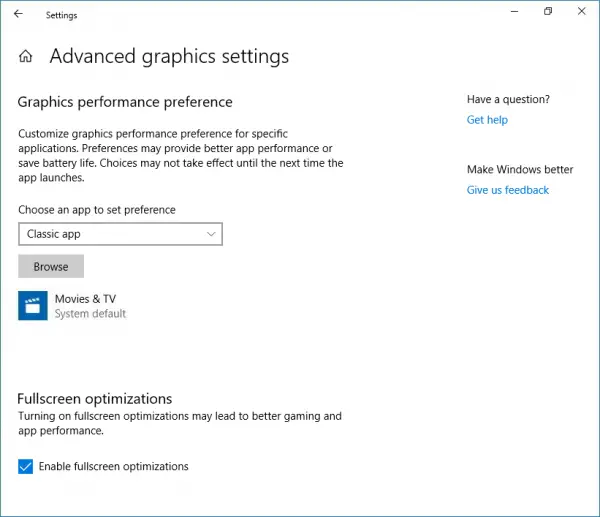
Under the section labeled as, Fullscreen optimizations, uncheck the option labeled as Enable Fullscreen optimizations to disable the feature.
Was that helpful?
Ayush has been a Windows enthusiast since the day he got his first PC with Windows 98SE. He is an active Windows Insider since Day 1 and has been a Windows Insider MVP.
Windows 10 and Windows 11 come with various features designed to enhance the gaming experience and the overall performance of applications. One such feature is Full-Screen Optimizations, which can wield considerable influence on how certain games and applications run on your system. While this feature generally aims to improve the Full-Screen experiences of users, there are instances where it may need to be disabled to troubleshoot specific issues or to further optimize performance. This guide will delve deep into Full-Screen Optimizations on Windows, explaining what it is, how it works, and providing detailed steps on how to enable or disable it on your system.
Understanding Full-Screen Optimizations
What Are Full-Screen Optimizations?
Full-Screen Optimizations introduced with Windows 10 aim to enhance full-screen applications’ performance. The feature allows Windows to resize the application window to fit the screen resolution while simultaneously managing how the application interacts with hardware resources. Full-Screen Optimizations can help with reducing latency and managing performance better in full-screen applications.
Benefits of Full-Screen Optimizations
- Improved Performance: The optimizations can improve frame rates and reduce input lag during gaming and video playback.
- Seamless Window Management: They allow users to toggle between full-screen and windowed application modes seamlessly.
- Compatibility: Many older applications and games work better with this feature enabled, making it a beneficial option for those who run legacy software.
Downsides of Full-Screen Optimizations
- Incompatibility with Some Games: Some gamers report issues such as stuttering or inconsistent frame rates when Full-Screen Optimizations are enabled. In these cases, disabling the feature can help.
- Reduced Performance in Certain Situations: Occasionally, the optimizations can be more resource-intensive, leading to decreased performance for specific applications or games.
Understanding these aspects can help you make informed decisions about whether to enable or disable Full-Screen Optimizations on your system.
Checking Full-Screen Optimizations
Before you make any changes, it’s valuable to check if Full-Screen Optimizations are already enabled for your applications and games. Here’s how you can go about it:
-
Locate the Application or Game: Find the executable (.exe) file of the program whose settings you want to manage. This could be in your installation directory (often found in
C:Program FilesorC:Program Files (x86)). -
Access Properties:
- Right-click on the executable file.
- Select Properties from the context menu.
-
Navigate to Compatibility Tab:
- In the Properties window, click on the Compatibility tab.
- Here, you should see a section titled «Settings,» which includes an option for Disable Full-Screen Optimizations.
-
Check Current Settings: If the checkbox for Disable Full-Screen Optimizations is unchecked, then Full-Screen Optimizations are currently enabled. If it’s checked, it means that they are disabled.
How to Enable Full-Screen Optimizations
If you’ve determined that Full-Screen Optimizations are turned off and you would like to enable them, follow these straightforward steps:
-
Repeat the Steps to Access Properties: Navigate to the exact executable file of the application or game. Right-click on it and choose Properties.
-
Access the Compatibility Tab: Again, click on the Compatibility tab in the Properties window.
-
Enable Full-Screen Optimizations: Under the «Settings» section, locate the checkbox for Disable Full-Screen Optimizations and make sure it is unchecked. This action enables the feature.
-
Apply and OK: Click on Apply to save your changes and then hit OK to exit the Properties window.
-
Restart the Application: Close the program if it’s running and restart it for your changes to take effect.
How to Disable Full-Screen Optimizations
If you notice performance issues with your applications during Full-Screen mode, you may need to disable Full-Screen Optimizations. Here’s how you do that:
-
Navigate to the Executable File: Just as before, find the .exe file of the application or game.
-
Open Properties as Before: Right-click on the file and select Properties.
-
Go to Compatibility Tab: Click on the Compatibility tab.
-
Disable Full-Screen Optimizations: In the «Settings» section, check the box next to Disable Full-Screen Optimizations. Checking this box will disable the feature.
-
Apply Your Changes: Click Apply, then hit OK.
-
Restart the Application: As with enabling the feature, ensure the application restarts for the new settings to come into effect.
Using Compatibility Mode
Another useful setting in conjunction with Full-Screen Optimizations is Compatibility Mode. This feature lets you run programs using Windows compatibility settings for older operating systems. Here’s how to invoke Compatibility Mode:
-
Locate Executable File: Right-click the application or game’s .exe file.
-
Select Properties: Choose Properties from the context menu.
-
Navigate to Compatibility Tab: Click on the Compatibility tab.
-
Run This Program in Compatibility Mode: Check the box labeled Run this program in compatibility mode for: and choose your desired version of Windows from the drop-down list.
-
Use Full-Screen Optimizations: Make sure that the Disable Full-Screen Optimizations box is unchecked if you still want the optimization to be active.
-
Apply Changes: Click Apply, then OK.
By combining these settings, you can achieve the best performance for games and applications that require it.
Additional Methods to Optimize Performance
Updating Graphics Drivers
Another essential step in optimizing game and application performance is ensuring you have the latest graphics drivers installed. Manufacturers like NVIDIA, AMD, and Intel frequently release updates that can vastly improve game performance and compatibility.
- Checking for Updates:
- In Windows, navigate to the Device Manager.
- Expand the Display adapters section to find your graphics card.
- Right-click on your graphics card and select Update driver.
- Follow the instructions to search automatically for updated driver software.
Alternatively, you can download the latest drivers directly from the manufacturer’s website.
Utilize Game Mode in Windows 10/11
Windows 10 and 11 also include a feature called Game Mode, which is designed to improve performance for gaming:
- Open Settings: Press Windows + I to open Settings.
- Go to Gaming: Click on Gaming.
- Access Game Mode: In the sidebar, select Game Mode.
- Enable Game Mode: Toggle the switch to turn it on.
By enabling Game Mode, Windows optimizes system resources for gaming applications, further enhancing performance.
Adjust in-game Settings
Often, in-game settings can lead to performance optimizations. Experiment with lower graphic settings such as resolution, shadow quality, and texture quality.
Troubleshooting Common Issues
Even after following the steps outlined to enable or disable Full-Screen Optimization, you may still run into problems. Here are a few common issues and possible solutions:
Stuttering or Frame Rate Drops
- Solution: This is often more about system limitations, outdated drivers, or hardware problems. Try disabling Full-Screen Optimizations or switching to windowed mode. Always keep your graphics drivers up to date.
Application Crashes
- Solution: Run the application in Compatibility Mode as discussed earlier. Ensure the application is updated, and check for compatibility with your current OS.
Input Lag
- Solution: This could be related to the game itself or related to the Full-Screen Optimizations feature. Disabling it, as described above, could help.
Black Screen Issues
- Solution: Some users report encountering a black screen when launching games. Disabling Full-Screen Optimizations as well as changing your screen resolution could potentially solve this issue.
Conclusion
Full-Screen Optimizations are a feature in Windows 10 and 11 that can both enhance and impede performance based on individual use cases. Understanding how to enable and disable this feature, coupled with other optimization techniques, equips you with the tools necessary for maximizing your gaming and application performance. By carefully evaluating the preferences and performance of the applications you run, you’ll make the most out of your Windows experience.
While the steps outlined in this guide are simple to follow, the impact they can have on performance is often significant. If you’re still experiencing issues, consider diving deeper into other optimization settings available in Windows, or seek advice from community forums or official support channels for specific applications.
The Fullscreen Optimizations feature of Windows 11/10 allows apps to function even better. This feature is enabled by default for applications like video players and games. When this feature is turned on, the gaming or video playback experience is enhanced by prioritizing the CPU and GPU resources for that particular process.
However, sometimes, it drops the frame rate (FPS) when the app runs in full-screen mode. To overcome this issue, you need to fix frame drops, and for that, you need to disable the fullscreen optimizations.
In this gearupwindows article, we will guide you on turning on and off the Fullscreen Optimizations for programs in Windows 11/10.
How to Enable or Disable Fullscreen Optimizations for Specific Apps or Games for Current Users?
To turn on or off Fullscreen Optimizations for a selected app or game for the current user, use the following steps:-
Step 1. Right-click on the executable file of the app or game and select the Properties option.

Step 2. Switch to the Compatibility tab.
Step 3. Check or uncheck the option Disable fullscreen optimizations to disable or enable this feature.
Step 4. Then, click Apply.
Step 5. Finally, hit the OK button.
How to Turn On or Off Fullscreen Optimizations for Specific Apps or Games for All Users?
To enable or disable Fullscreen Optimizations for a specific app or game for all users, do the following:-
Step 1. Right-click on the app or game executable file and select the Properties option.
Step 2. Then, click the Compatibility tab.

Step 3. After that, click the Change settings for all users button.
Step 4. Next, check or uncheck the option Disable fullscreen optimizations to disable or enable this feature.
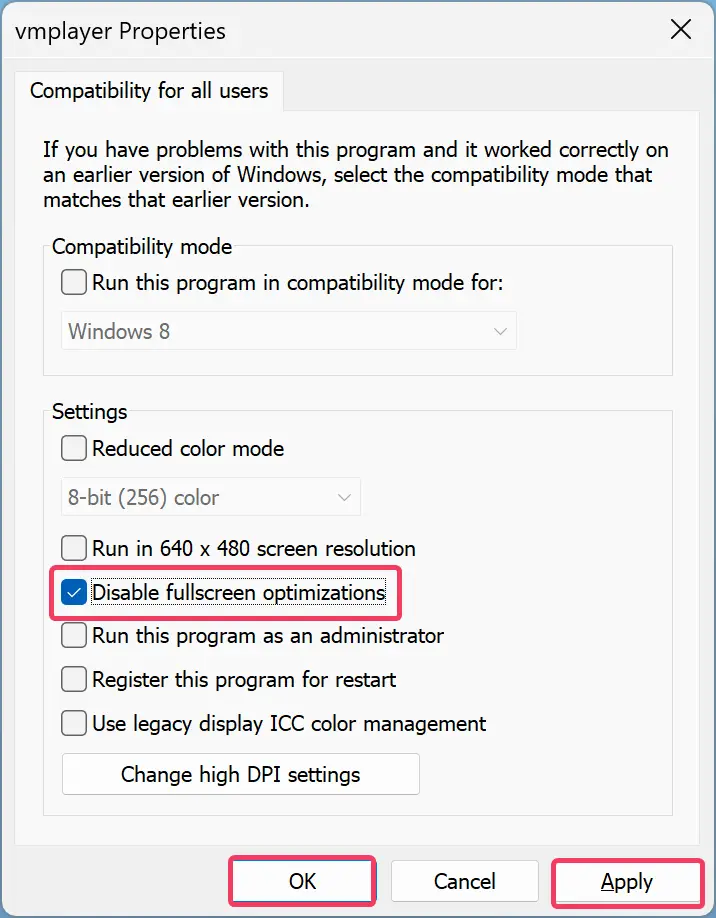
Step 5. Click Apply.
Step 6. Click OK.
Step 7. Click Apply.
Step 8. Click OK.
How to Enable or Disable Fullscreen Optimizations for Apps Using Registry Editor?
To turn on or off Fullscreen Optimizations for apps through Registry Editor, do the following:-
Step 1. Open the Registry Editor.
Step 2. When Registry Editor appears on your computer, navigate to the following in the left sidebar:-
Computer\HKEY_CURRENT_USER\System\GameConfigStore
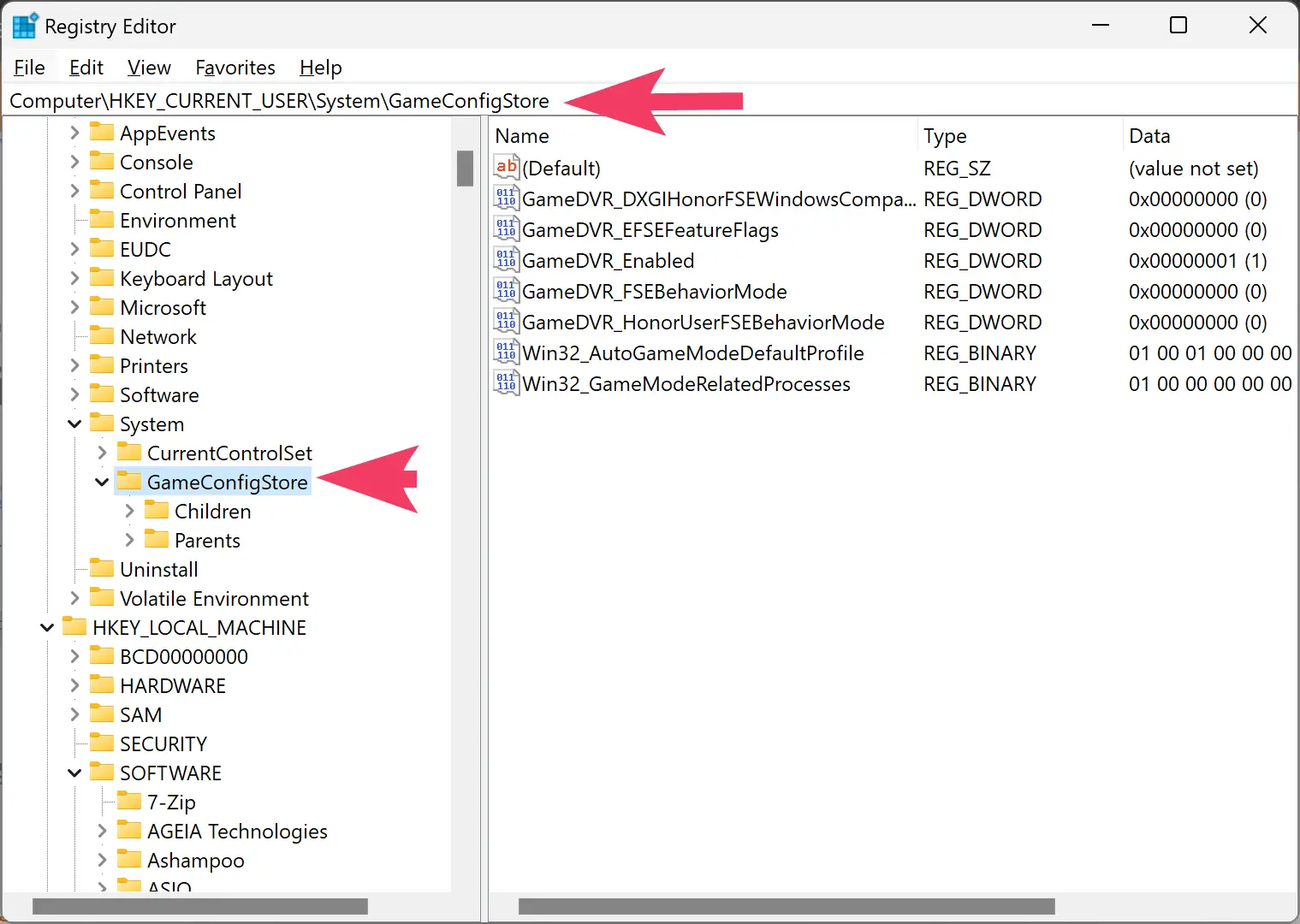
Step 3. Then, right-click on the GameConfigStore folder and select New > DWORD (32-bit) Value.
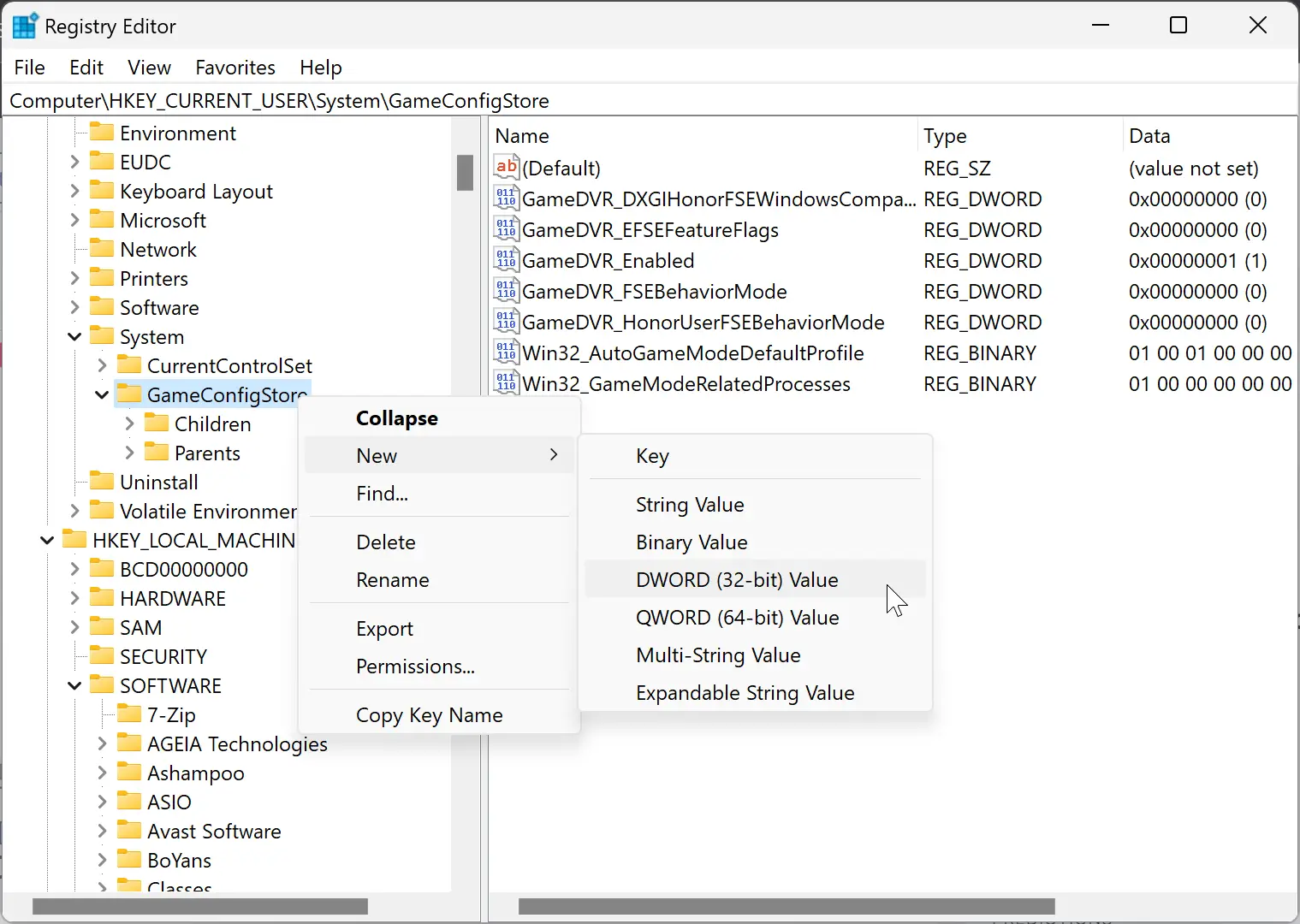
Step 4. Name the newly created REG_DWORD as GameDVR_FSEBehavior.
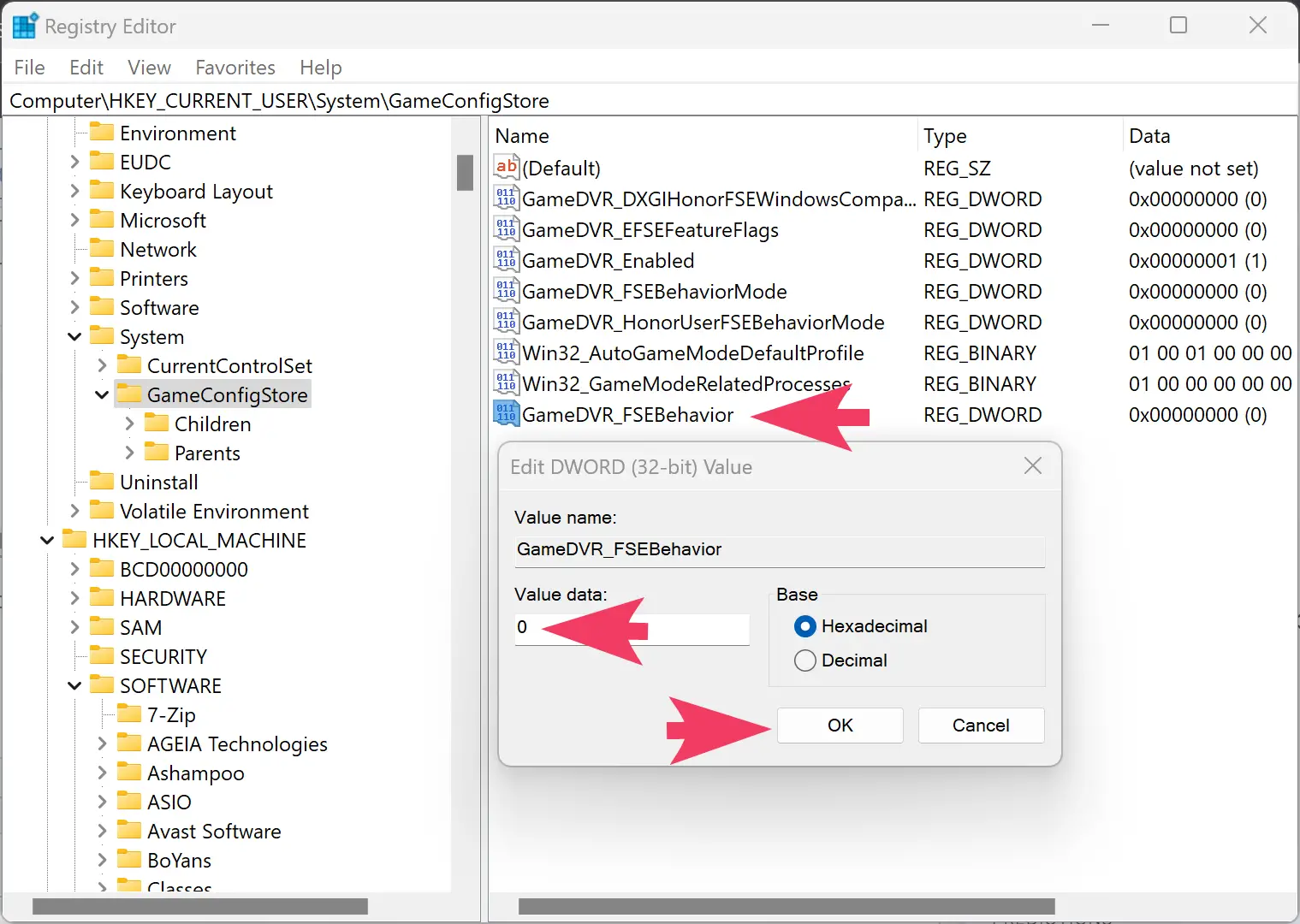
Step 5. Now, double-click on the GameDVR_FSEBehavior and set the “Value data” to the following:-
- 0: Enable Fullscreen optimizations.
- 2: Disable Fullscreen optimizations.
Step 6. Finally, reboot your computer to apply the changes.
Conclusion
Windows 11/10’s Fullscreen Optimizations feature is a strategic move towards refining application performance, especially in games and video players. It works by leveraging the power of both CPU and GPU to enhance the user’s gaming or video-watching experience. But, as with many optimizations, it’s not one-size-fits-all. Some users may experience frame rate drops in full-screen mode, necessitating the feature’s deactivation. This gearupwindows guide has illuminated the pathways to enable or disable this feature, be it for specific apps or universally, using either the properties menu or the Registry Editor. Harnessing this knowledge allows users to enjoy a tailored and optimal Windows experience.
